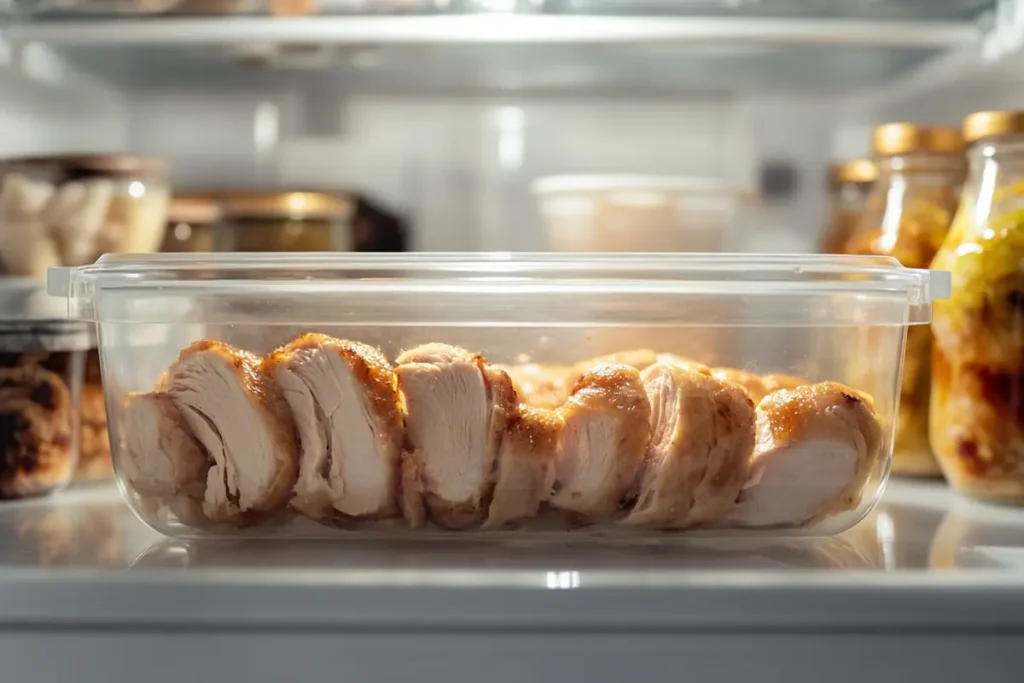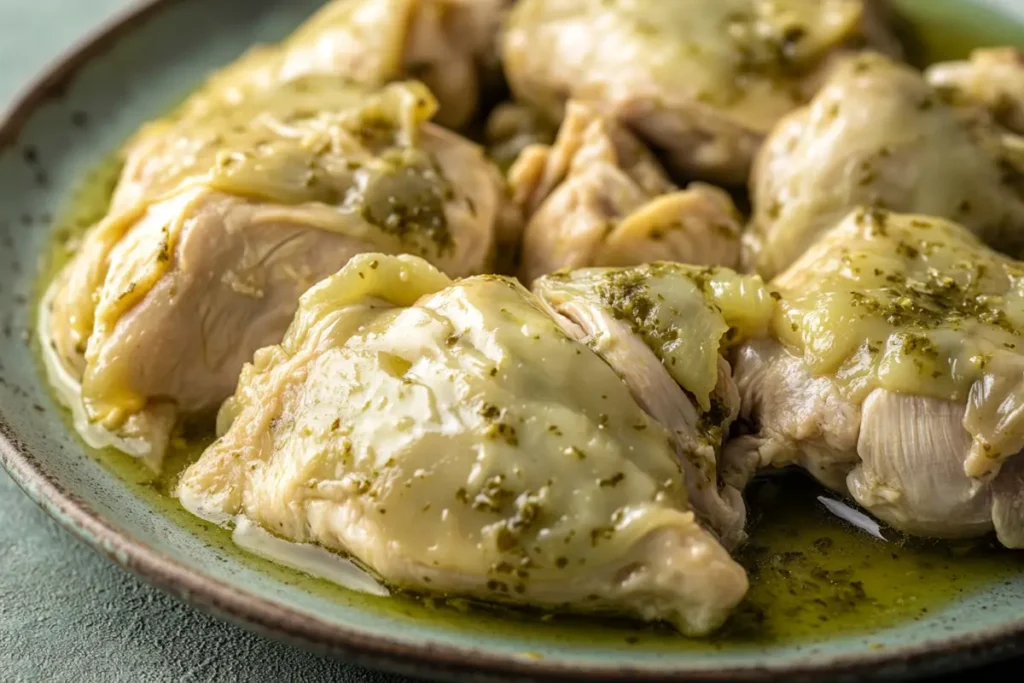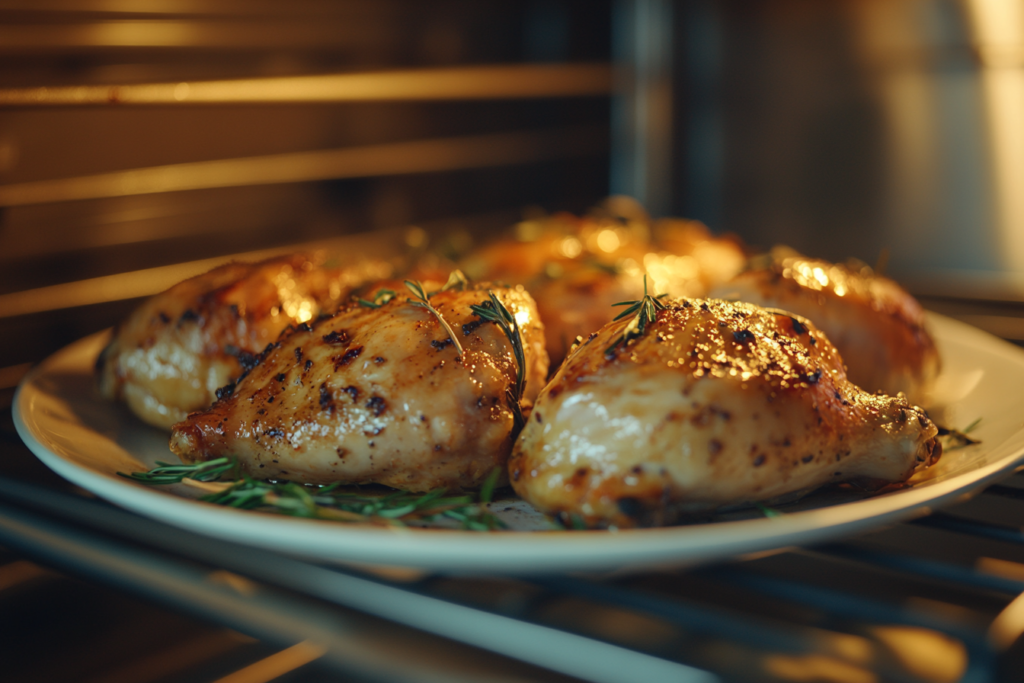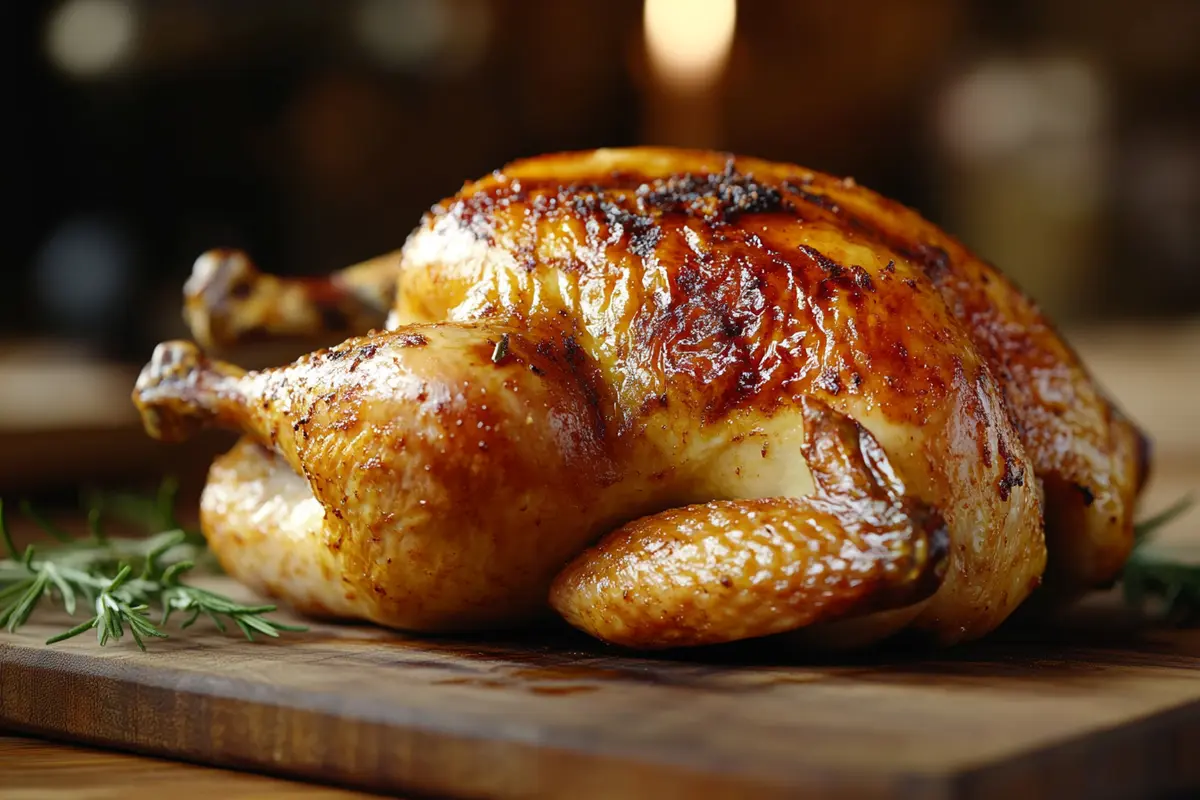Rotisserie chicken is a quick and tasty meal option, but what happens when you have leftovers? How long is leftover rotisserie chicken good in the fridge? If you’re wondering whether last night’s delicious dinner is still safe to eat, you’re not alone.
In this guide, we’ll cover everything you need to know about storing, freezing, and reheating rotisserie chicken. You’ll learn the best ways to keep it fresh, how to tell if it’s spoiled, and even some creative meal ideas to use up leftovers. Let’s dive in!
Understanding Rotisserie Chicken Storage
How Long Does Rotisserie Chicken Last in the Fridge?
So, how long is leftover rotisserie chicken good in the fridge? Generally, cooked chicken, including store-bought rotisserie chicken, lasts 3 to 4 days in the refrigerator. The key to keeping it fresh is proper storage. If left at room temperature for too long, bacteria can multiply quickly, making it unsafe to eat.
To maximize its shelf life, always store leftover rotisserie chicken in an airtight container or wrap it tightly in plastic wrap or aluminum foil. Keep it in the coldest part of your fridge, ideally at 40°F (4°C) or below.
Factors Affecting the Shelf Life of Rotisserie Chicken
Several factors determine how long your rotisserie chicken stays safe to eat:
- Storage Method: Chicken stored in an airtight container lasts longer than loosely wrapped leftovers.
- Fridge Temperature: A colder fridge slows bacterial growth, keeping food fresh longer.
- Initial Handling: If the chicken was left out for more than 2 hours before refrigerating, it might already be unsafe to eat.
- Moisture Levels: Exposure to excess moisture can cause bacteria to grow faster, making the chicken spoil quicker.
How Bacteria Grow on Stored Chicken
Bacteria thrive in what food safety experts call the “danger zone” (40°F to 140°F). When cooked chicken sits in this range for too long, harmful bacteria like Salmonella and Listeria can grow rapidly.
Here’s how bacteria develop in different conditions:
- Room Temperature (Above 68°F/20°C): Bacteria can double in number every 20 minutes.
- Fridge (Below 40°F/4°C): Growth slows significantly, allowing chicken to last 3 to 4 days.
- Freezer (Below 0°F/-18°C): Bacteria become dormant, preserving chicken for up to 4 months.
To stay safe, refrigerate your rotisserie chicken promptly and always check for signs of spoilage before eating.
Proper Storage Techniques to Maximize Freshness
The Best Way to Store Leftover Rotisserie Chicken in the Fridge

If you want to keep your rotisserie chicken fresh and safe to eat, proper storage is key. But how long is leftover rotisserie chicken good in the fridge when stored correctly? The answer is 3 to 4 days—but only if you follow the best storage practices.
The moment you’re done eating, transfer the leftover chicken into an airtight container or wrap it tightly in plastic wrap or aluminum foil. This prevents moisture loss and keeps bacteria from contaminating the food. Also, make sure your fridge is set to 40°F (4°C) or below to maintain optimal freshness.
Should You Leave the Chicken in Its Original Packaging?
Many store-bought rotisserie chickens come in a plastic container with a clear lid. While convenient, these containers are not airtight, meaning the chicken can dry out quickly and absorb odors from other foods in the fridge.
For better results:
- Remove the chicken from the store packaging as soon as possible.
- Transfer it to a glass or plastic airtight container.
- Wrap individual portions separately for easy reheating later.
How to Wrap and Contain Rotisserie Chicken Properly
If you don’t have an airtight container, you can still keep your chicken fresh by wrapping it properly. Use a double layer of plastic wrap or aluminum foil to prevent air exposure. Alternatively, store pieces in resealable freezer bags, pressing out excess air before sealing.
For best results, store chicken in the coldest part of the fridge, typically near the back or lower shelves, where the temperature is most stable.
What Fridge Temperature is Ideal for Storing Cooked Chicken?
Food safety experts recommend keeping refrigerators at 40°F (4°C) or below. If the temperature rises above this, bacteria like Salmonella and Listeria can multiply, increasing the risk of foodborne illness.
To ensure your fridge is at the right temperature:
- Use a fridge thermometer to monitor temperature levels.
- Avoid overloading the fridge, as crowded shelves can block cold air circulation.
- Store chicken away from raw meats to prevent cross-contamination.
By following these steps, you can keep your leftover rotisserie chicken safe and fresh for up to 4 days in the refrigerator.
Signs Your Leftover Rotisserie Chicken Has Gone Bad
How to Tell If Cooked Chicken is Spoiled

No one wants to eat spoiled chicken! But how long is leftover rotisserie chicken good in the fridge before it starts to go bad? Usually, 3 to 4 days is the limit—but sometimes, chicken can spoil sooner if not stored properly.
Here’s how to check if your rotisserie chicken has gone bad:
- Smell: A sour, rancid, or ammonia-like odor is a major red flag. Fresh chicken has little to no smell.
- Texture: If the chicken feels slimy or sticky, bacteria may already be growing on it.
- Color: Grayish or greenish patches indicate spoilage, and it’s best to discard the chicken immediately.
Visual Indicators of Spoilage
Fresh rotisserie chicken should have a golden-brown exterior with moist, white or slightly pink meat inside. If you notice discoloration or mold spots, the chicken is no longer safe to eat.
Another clear sign is dried-out or hardened meat, which means the chicken has been in the fridge too long. While not necessarily unsafe, it won’t taste good.
Smell and Texture Changes to Watch For
Spoiled chicken has a strong, off-putting odor that’s hard to ignore. If it smells sour, sulfuric, or rotten, throw it out immediately.
Texture changes are another giveaway. If the meat is sticky, excessively wet, or slimy, bacteria have already started multiplying. Never rinse slimy chicken—this can spread bacteria around your kitchen.
Why You Should Never Eat Questionable Chicken
If you’re unsure whether your leftover rotisserie chicken is still safe, don’t risk it. Eating spoiled chicken can lead to food poisoning, causing symptoms like nausea, vomiting, diarrhea, and fever.
To stay safe, always err on the side of caution. When in doubt, throw it out!
Can You Freeze Rotisserie Chicken?
How Freezing Can Extend Rotisserie Chicken’s Shelf Life
If you can’t finish your rotisserie chicken within a few days, freezing is an excellent option. But how long is leftover rotisserie chicken good in the fridge before freezing becomes necessary? Generally, if you won’t eat it within 3 to 4 days, freezing is the best way to prevent spoilage.
When frozen properly, rotisserie chicken can last up to 4 months while maintaining its flavor and texture. Freezing not only reduces food waste but also ensures you always have cooked chicken ready for quick meals.
Best Practices for Freezing Cooked Chicken
To keep your chicken fresh in the freezer, follow these best practices:
- Cool the chicken first – Never freeze warm chicken, as it can cause moisture buildup and freezer burn. Let it cool to room temperature before packing.
- Portion it out – If you won’t be using the whole chicken at once, separate it into individual portions before freezing. This makes thawing and reheating easier.
- Use airtight storage – Wrap the chicken tightly in plastic wrap, aluminum foil, or store it in freezer-safe bags or containers to prevent freezer burn.
- Label and date – Always write the freezing date on the packaging so you know when to use it.
How Long Can Rotisserie Chicken Last in the Freezer?
Properly stored rotisserie chicken remains safe to eat for up to 4 months in the freezer. However, for the best taste and texture, try to consume it within 2 to 3 months.
How to Properly Thaw Frozen Rotisserie Chicken
There are a few safe methods for thawing rotisserie chicken:
- Refrigerator thawing (Best Method) – Transfer the frozen chicken to the fridge 24 hours before you plan to use it.
- Cold water thawing – Place the chicken in a sealed plastic bag and submerge it in cold water, changing the water every 30 minutes until thawed.
- Microwave thawing – Use your microwave’s defrost setting, but be ready to cook it immediately after thawing to avoid bacterial growth.
Safe Reheating and Consumption Tips
Can You Refrigerate and Reheat Rotisserie Chicken?
Yes! If you’ve stored it properly, reheating rotisserie chicken is perfectly safe. However, make sure to heat it to 165°F (74°C) to kill any bacteria.
The Safest Methods to Reheat Leftover Chicken

There are several ways to reheat rotisserie chicken while keeping it juicy and flavorful:
- Oven (Best for Whole Chicken or Large Pieces)
- Preheat oven to 350°F (175°C).
- Place the chicken in an oven-safe dish and cover with foil to prevent drying out.
- Heat for 20-25 minutes or until it reaches 165°F (74°C) internally.
- Stovetop (Best for Small Pieces)
- Heat a pan over medium heat and add a splash of water or broth.
- Cook chicken, stirring occasionally, until heated through.
- Microwave (Quickest Method)
- Place chicken on a microwave-safe plate, cover with a damp paper towel, and microwave in 30-second intervals until warm.
How Many Times Can You Safely Reheat Rotisserie Chicken?
It’s best to reheat chicken only once. Repeated reheating increases the risk of bacteria growth and can make the meat dry and tough.
Why Reheating Chicken to 165°F is Essential
Food safety experts recommend reheating chicken to 165°F (74°C) to destroy harmful bacteria like Salmonella and Listeria. Always use a food thermometer to check the internal temperature before eating.
Nutritional Value of Rotisserie Chicken (Per 100g)
Rotisserie chicken is a high-protein, low-carb food that provides essential nutrients. Below is the nutritional breakdown per 100 grams of rotisserie chicken (without skin):
| Nutrient | Amount per 100g |
|---|---|
| Calories | 200 kcal |
| Protein | 27 g |
| Fat | 8 g |
| Saturated Fat | 2.2 g |
| Cholesterol | 85 mg |
| Sodium | 400 mg |
| Carbohydrates | 0 g |
| Iron | 1 mg |
Is Rotisserie Chicken Healthy?
Rotisserie chicken is a great source of lean protein, making it ideal for muscle growth and repair. It’s also packed with essential vitamins and minerals, such as iron, zinc, and B vitamins. However, be mindful of the sodium content, especially if you’re watching your salt intake.
Frequently Asked Questions (FAQs)
Can You Eat Rotisserie Chicken After 5 Days?
No, it’s not safe to eat rotisserie chicken after 5 days, even if it looks and smells fine. According to the USDA, cooked chicken should be eaten within 3 to 4 days when stored at 40°F (4°C) or lower. After this period, bacteria like Salmonella and Listeria can multiply, increasing the risk of food poisoning. If you’re unsure, always err on the side of caution and throw it out. Freezing the chicken within the first few days can help extend its shelf life.
How Long Can a Costco Rotisserie Chicken Last in the Refrigerator?
A Costco rotisserie chicken follows the same food safety guidelines as any other cooked chicken. When properly stored in an airtight container or wrapped tightly in foil or plastic wrap, it remains fresh for 3 to 4 days in the fridge. If you won’t eat it in time, freezing is the best way to keep it fresh longer. Consider shredding or portioning it before freezing for easy meal prep later.
Can You Refrigerate and Reheat Rotisserie Chicken?
leftover rotisserie chicken good in the fridge? It’s safe to refrigerate for up to 4 days, provided it is stored properly. When reheating, always bring the internal temperature to 165°F (74°C) to kill any bacteria. The best reheating methods include:
Oven: Reheat at 350°F (175°C) for 20-25 minutes while covered to prevent dryness.
Stovetop: Warm with a splash of broth or water over medium heat for 5-10 minutes.
Microwave: Heat in 30-second intervals, covering the chicken with a damp paper towel to retain moisture.
To prevent bacterial growth, reheat only what you plan to eat and avoid reheating multiple times.
How Can You Tell If Cooked Chicken is Spoiled?
Even if your chicken has been stored properly, it’s important to check for signs of spoilage before eating. Here’s what to watch for:
Off-putting smell: If the chicken has a sour, rotten, or ammonia-like odor, it’s no longer safe to eat.
Slimy texture: A sticky or slimy surface means bacteria have started to grow.
Unusual color: If the meat looks gray, green, or has mold spots, discard it immediately.
Mushy or dried-out meat: While not necessarily unsafe, chicken that has an odd texture is best avoided.
If you notice any of these signs, do not taste the chicken—just throw it out.
Conclusion
So, how long is leftover rotisserie chicken good in the fridge? The best rule of thumb is to eat it within 3 to 4 days when stored in an airtight container at 40°F (4°C) or lower. If you need to keep it longer, freezing it in airtight packaging can extend its shelf life up to 4 months.
When it’s time to reheat, always ensure the chicken reaches 165°F (74°C) for safe consumption. Never take risks with spoiled chicken—if it smells bad, feels slimy, or looks discolored, it’s best to throw it out.
Rotisserie chicken is a versatile and delicious meal option, perfect for quick dinners, meal prep, and creative leftovers. By storing, freezing, and reheating it correctly, you can enjoy every bite while keeping your meals safe and flavorful!
Print
Proper Storage & Shelf Life of Leftover Rotisserie Chicken
- Total Time: 5 minutes
- Yield: Varies
Description
Wondering whether last night’s juicy rotisserie chicken is still safe to eat? Learn how long leftover rotisserie chicken lasts in the fridge, how to store it properly, and tips for freezing and reheating it to avoid foodborne illness.
Ingredients
Store-bought or homemade rotisserie chicken
Airtight container or resealable freezer bags
Plastic wrap or aluminum foil
Fridge thermometer (recommended)
Instructions
-
Refrigerate Promptly: Transfer leftover chicken to the fridge within 2 hours of cooking or purchasing.
-
Use Airtight Storage: Place chicken in an airtight container or wrap tightly in plastic wrap or foil to prevent air exposure.
-
Label & Date: Note the date on the container so you know when to consume or freeze it.
-
Store in Coldest Area: Keep chicken in the back or lower shelf of the fridge where temperatures are most stable.
-
Check Before Eating: Discard chicken if it smells sour, feels slimy, or has discolored or moldy patches.
-
Freeze if Needed: If not eaten within 3–4 days, freeze in portioned airtight packages. Label with date.
-
Thaw Safely: Thaw in the refrigerator overnight or in cold water; never leave it at room temperature.
-
Reheat Thoroughly: Heat to an internal temperature of 165°F (74°C) before consuming.
Notes
Avoid storing in the original store packaging—it’s not airtight.
For convenience, portion leftovers before freezing.
Never rinse spoiled chicken; discard it to avoid cross-contamination.
- Prep Time: 5 minutes
- Cook Time: 0 minutes
- Category: Dinner
- Method: Refrigerating & Freezing
- Cuisine: American
Nutrition
- Serving Size: 100g
- Calories: 200 kcal
- Sugar: 0g
- Sodium: 400mg
- Fat: 8g
- Saturated Fat: 2.2g
- Unsaturated Fat: 5.8g
- Trans Fat: 0g
- Carbohydrates: 0g
- Fiber: 0g
- Protein: 27g
- Cholesterol: 85mg
Keywords: leftover rotisserie chicken storage, fridge safety, how to freeze cooked chicken, spoilage signs, how to store rotisserie chicken, chicken safety guide

